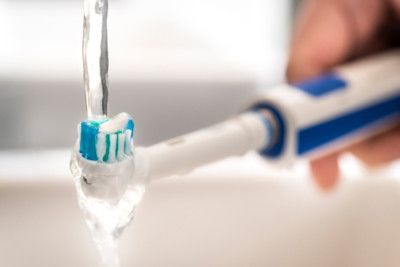Which toothbrush is the right one?
It is used twice a day: the toothbrush. They come in a wide variety of designs. Everyone should choose the toothbrush that suits him or her!
Basically, according to current studies, an electric toothbrush cleans better than a manual toothbrush. Because with manual toothbrushes, a comparably good result can only be achieved with optimal brushing technique – and not everyone has that.
Manual toothbrushes – Taking time to brush
“If you are willing to invest a little more time in brushing your teeth, you can compensate for the disadvantage of the manual toothbrush,” explains Prof. Dr. Stefan Zimmer, Head of the Department of Dental Preservation and Preventive Dentistry at the University of Witten/Herdecke.
“Depending on the dentition, this can be a good five minutes or more per brushing. Because time is always the critical factor when brushing teeth.” A slightly larger toothbrush head cleans more tooth surface in the same time as a small one.
However, a small brush head can work on each tooth individually. Since the surface of the teeth is not flat, the outer bristles of the brush should be longer than the inner ones.
The longer bristles automatically slide into the spaces between the teeth and into the area of the gum line. You clean these areas better.
Brushing teeth – it’s the technique that counts
Toothbrushes with hard bristles clean best. They are suitable for all those who have a particularly large amount of plaque but no problems with gum damage – provided the correct brushing technique is used.
But beware: Brushing incorrectly or scrubbing too hard can damage gums with hard bristles. On the other hand, hard bristles are gentler on the dentin than soft bristles.
Hard bristles work only with the tips on the tooth surface. Soft bristles can bend and rub the toothpaste with their abrasive substances more intensively on the tooth. It is not the bristles that abrade the enamel, but toothpastes with hard abrasives.
For sensitive teeth and exposed necks of teeth, the bristles should therefore be rather hard and a gently cleaning toothpaste should be used.
If you are unsure, you can choose a toothbrush with medium bristle hardness. It is a good compromise between brushing efficiency, protection of enamel and dentin, and the risk of gum damage.
Electric toothbrushes – make brushing teeth easier
Electric toothbrushes simplify the brushing movements. Because they perform the small movements on the tooth automatically.
Numerous studies have shown that electric toothbrushes are more effective than manual toothbrushes when used regularly and systematically.
This helps to prevent periodontitis, i.e. inflammation of the tissue surrounding the tooth (periodontium).
Two types of toothbrushes – two brushing techniques
With electric toothbrushes, it is important to pay close attention to the recommended use for the toothbrush type. On the one hand, there are the oscillating-rotating toothbrushes. They have round heads that oscillate back and forth as well as pulsate to some extent.
Each tooth must be carefully cleaned individually from all three sides. On the other hand there are sound-active toothbrushes. They have an elongated head and clean by vibration as well as sideways swinging bristle fields.
Sonic toothbrushes are easier to use and clean more area at once. Which brush is the right one is determined by the brushing behavior.
